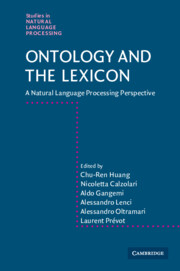Book contents
- Frontmatter
- Contents
- Contributors
- Preface
- Part I Fundamental aspects
- Part II Discovery and representation of conceptual systems
- Part III Interfacing ontologies and lexical resources
- 10 Interfacing ontologies and lexical resources
- 11 Sinica BOW (Bilingual Ontological WordNet): integration of bilingual WordNet and SUMO
- 12 Ontology-based semantic lexicons: mapping between terms and object descriptions
- 13 Merging global and specialized linguistic ontologies
- Part IV Learning and using ontological knowledge
- References
- Index
12 - Ontology-based semantic lexicons: mapping between terms and object descriptions
from Part III - Interfacing ontologies and lexical resources
Published online by Cambridge University Press: 06 July 2010
- Frontmatter
- Contents
- Contributors
- Preface
- Part I Fundamental aspects
- Part II Discovery and representation of conceptual systems
- Part III Interfacing ontologies and lexical resources
- 10 Interfacing ontologies and lexical resources
- 11 Sinica BOW (Bilingual Ontological WordNet): integration of bilingual WordNet and SUMO
- 12 Ontology-based semantic lexicons: mapping between terms and object descriptions
- 13 Merging global and specialized linguistic ontologies
- Part IV Learning and using ontological knowledge
- References
- Index
Summary
Introduction
An important requirement for the semantic analysis of textual documents, in areas such as document classification, information retrieval, and information extraction, is the annotation of terms with semantic classes. This allows for a normalization of semantically similar terms to the same semantic class. Such information is provided by a variety of semantic lexicons, ranging from synonym lists (Roget) and lexical semantic databases derived from machine-readable dictionaries (Longman Dictionary of Contemporary English, Webster) to wordnets (WordNet (Miller et al., 1990), EuroWordNet (Vossen, 1998) and similar resources).
However, the employment of such resources in real-world applications is hampered by a number of problems. On the one hand, in general, there are too many fine-grained senses represented, and second, many of those senses are of no relevance to the application, i.e., to the specific domain under consideration, whereas, on the other hand, domain-specific terms often carry interpretations (i.e., senses) that are not represented in the resource, for one of two reasons: either the interpretation is not associated with this term, or it is not available at all.
An application-oriented approach to semantic lexicons would instead focus on the semantics of the application, i.e., as represented by an ontology of the application domain. An ontology-based semantic lexicon would leave the semantics to the ontology, focusing instead on providing the mappings between domain-specific (and more general) terms and the class-based object descriptions in the ontology.
- Type
- Chapter
- Information
- Ontology and the LexiconA Natural Language Processing Perspective, pp. 212 - 223Publisher: Cambridge University PressPrint publication year: 2010
- 6
- Cited by



